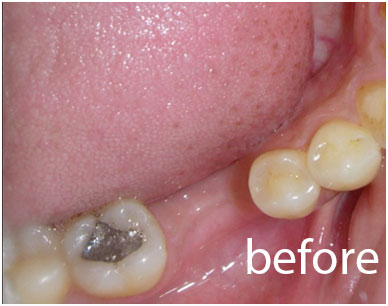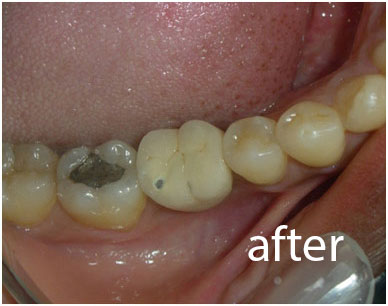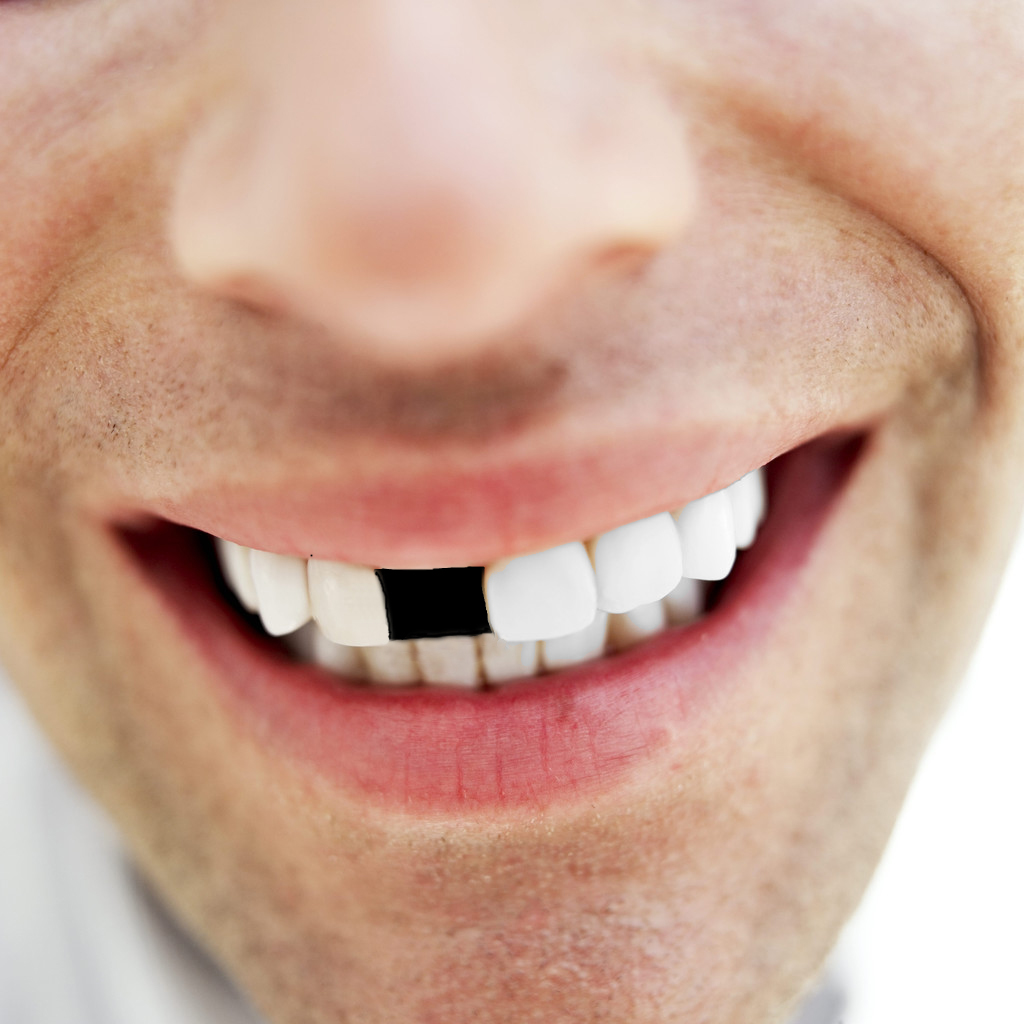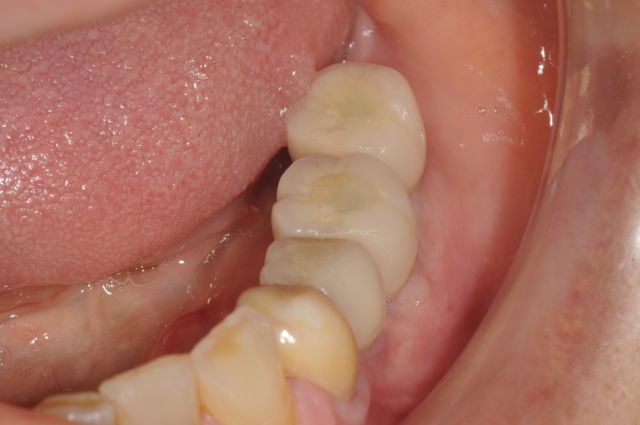If you have a missing tooth due to caries, trauma or periodontal disease, or another cause, there is hope. Dental implants are changing the way people live! They are designed to provide a foundation for replacement teeth that look, feel, and function like natural teeth. The person who has lost teeth regains the ability to eat virtually anything and can smile with confidence, knowing that teeth appear natural and that facial contours will be preserved. Patients with dental implants can smile with confidence.
When a single tooth is missing the two most common universal treatment options are:
The oldest & even today, fixed bridges were the best alternative for people who had lost single or multiple teeth, as they were quite successful and esthetically pleasing. When a tooth-supported fixed bridge is used to replace one missing tooth, the teeth on each side of the missing tooth are prepared (in other words trimmed) to develop a support system. This process unfortunately destroys natural enamel and tooth structure, but must be done in order to fit the new cemented fixed bridge in place. Read More
Now day’s dental implant supported tooth is the treatment of choice to replace single missing teeth, thanks to the advancement of modern dentistry exclusively to Prosthetic Dentistry. Dental implant is the best, strongest & simplest way to replace your single missing tooth & is looks, feels & function like a natural tooth. The teeth on each side of the missing tooth no longer need to be cut or destroy.
Ask us at 3D Dental Implant Clinic – specialized center for Dental Implant in Kolkata for more details about single tooth replacement with dental implants & its other alternatives.


As you know dental implant is a highly précis, scientifically made artificial root, made of biocompatible material – titanium, that also most commonly used in orthopedic for joint replacement, plating of fracture site etc. The procedure for single tooth replacement by dental implant is relatively very simple. A small hole is very precisely drilled into the bone at the site of missing tooth. The selected implant is placed into the prepared site. The implant is allowed to heal for 2 to 4 months so that it should bond with the jaw bone known as osseointegration. During this healing time, you can wear a temporary tooth. During the healing phase you won’t even know the implant is there. After healing is completed the implant is uncovered, a measurement of adjacent teeth made to fabricate the crown & then the crown (artificial tooth) is placed on the implant to replace the missing tooth.
Loss of a front tooth, whether due to an accident or decay, can be a very traumatic experience for a person. A dental implant is a great treatment option for replacement. However the front teeth and the surrounding smile zone present unique challenges that make therapy in this area among the most difficult to do. Although nowdays every dentist can claim to replace a missing tooth but in reality it is the Prosthodontist who will give you an extraordinary treatment outcome in terms of cosmetic & aesthetic value. It requires the most expertise of Prosthodontist in both diagnostic and technical protocols. There are the 5 key principles every patient should know about how to achieve great results with dental implants in the smile zone or to know more visit dr. Harendra shahi, Prosthodontist & Implantologist at 3D Dental Implant clinic kolkata.


Missing central incisors are best replaced with dental implants and restored with customized crown.If both incisors are missing, then each should be replaced with a single dental implant or ask your Prosthodontist the best location & number of implants.

Lateral incisors have smaller dimension than central incisors and often there is minimal space for implant placement. Hence, it is critical to have an accurate measurement to determine between regular or narrow size implants.If both incisors are missing, then each should be replaced with a single dental implant or ask your Prosthodontist the best location & number of implants.

If you have multiple missing adjacent teeth in the upper or lower front area of your mouth, implants are often placed in staggering position to allow better development of gum tissue architecture.
The molars and premolars make up the back or posterior teeth of the mouth and they are responsible for grinding and processing food during chewing. They support the major forces of biting and chewing.

The best treatment approach is to replace each missing tooth with an implant. If multiple teeth are missing adjacent to each other, it is best place one implant per missing tooth for support of a single crown. Bridges (several teeth supported by fewer implants) are not routinely recommended with few exception. The best judge is the Prosthodontist who will determine the treatment plant that best suits to your mouth.

The location of the maxillary sinus and dimension of available bone must be carefully assessed using a CBCT (cone beam CT scan) to allow selection of correct implant size. The upper jaw bone is weaker and less dense relative to the lower jaw bone, hence longer healing time for integration may be necessary. Immediate restorations (loading) should also be done with caution. If there is inadequate height of bone due to sinus position, a sinus lift bone grafting technique is indicated.

In The lower jaw quality & quantity of available bone at missing teeth side and variations in anatomy also require A CBCT (cone beam CT scan) to select the proper size and position of the implant. A 3-D planning helps to accurately predict the position of the implant for a desired and precise outcome.
Treatment options and designs for your new teeth are customized specifically based on your needs, goals, existing dental condition, and the best long-term prognosis. This requires evaluation by a surgeon and your restorative dentist and close collaboration to design a customized treatment plan.

In staged or delayed treatment option, the implant is placed 2-3 months after the tooth is extracted. This allows adequate bone healing for improved implant support. If the extraction site was grafted, then the implant is placed in five to six months.

With immediate approach, the tooth is extracted and the implant is immediately placed in the site. some minor grafting is often necessary to preserve the bone and gum tissue architecture. The implant is allowed to heal for 3-6 months depending on the circumstances before it is restored.

Tooth-in-a-day refers to extraction of a tooth with immediate placement of dental implant and temporary restoration. This way, patient has a fixed temporary tooth supported by the implant. The final tooth is then placed in 3-6 months depending on the circumstances.